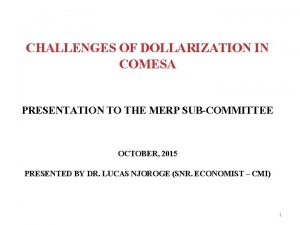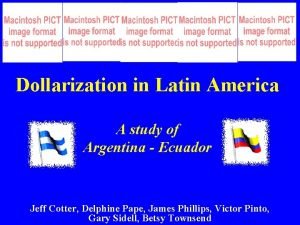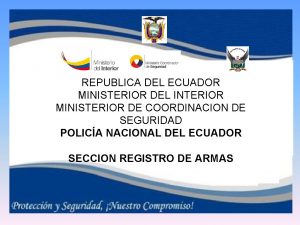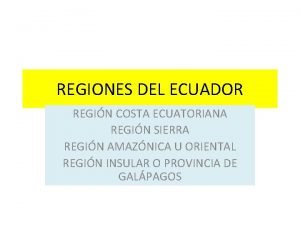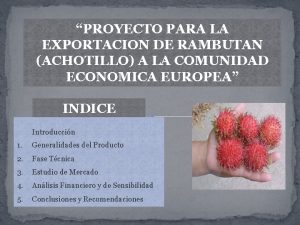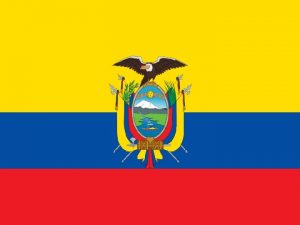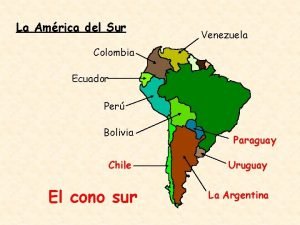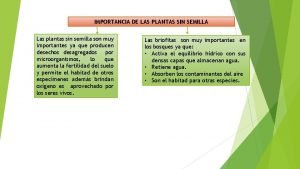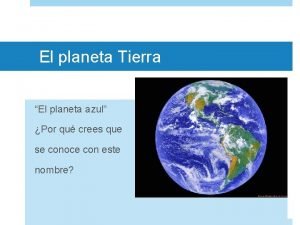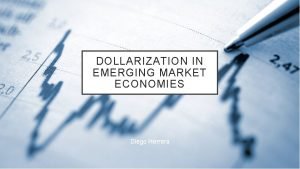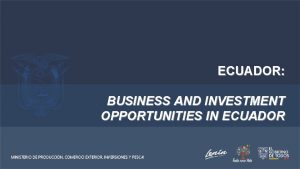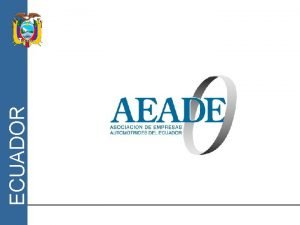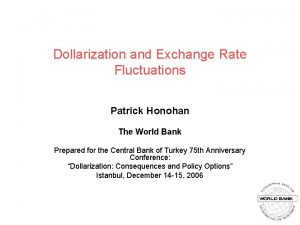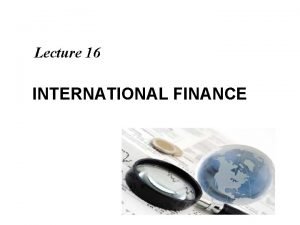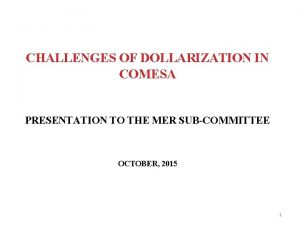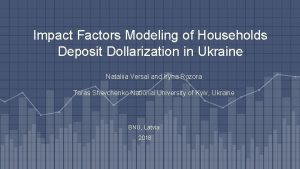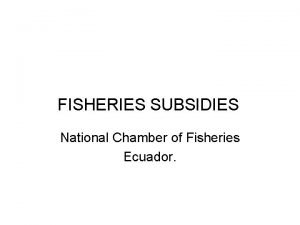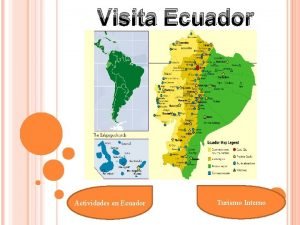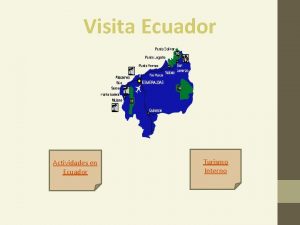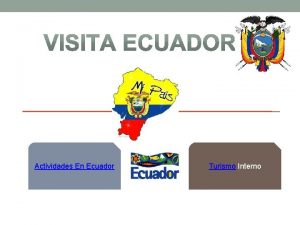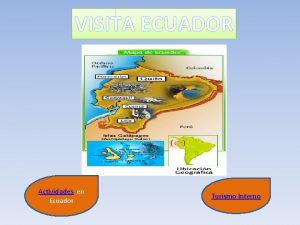NS 4540 Ecuador Dollarization and its effects Ecuador


























- Slides: 26

NS 4540 Ecuador Dollarization and it’s effects Ecuador Dollarization and it’s Effects By By David Del Valle

Ecuador

Dollarization $ in emerging economies Positive? Negative?

Summary • • • When and the reason why Ecuador dollarized? The effects of dollarization in Ecuador. Advantages and disadvantages Long term benefit Conclusion

Ecuador


Problems leading up to Dollarization • Ecuador had a slew of problems leading up to the time they dollarized. • Lower oil prices resulted in economic stagnation throughout the 1980 s and into the 1990 s. • Ecuadorean banks experienced a credit boom in the 1990 s.

Problems leading up to Dollarization • El Niño in 1997 -1998 • Several financial crises Globally • Oil prices plunged in 1998. • These shocks created a situation where the public deficit grew uncontrollably.

Problems leading up to Dollarization • President’s were changing out quickly as the banking crisis was developing. • The banking crisis started in April 1998

Problems leading up to Dollarization • A new law starting in January 1999 on tax. • The ADG comes into effect. • Sucre hyperinflation • Deposit Freeze exacerbates the problem. • Widespread Bank failures. • Government defaults on external debts.

Ecuador GDP vs Inflation

Ecuador Dollarization background • Panama adopted the dollar in 1904, shortly after its independence from Colombia. • Almost a century later, Ecuador and El Salvador followed suit, with Ecuador making the switch in 2000 and El Salvador in 2001.

Ecuador Dollarization background • Ecuadorian president Jamil Mahuad announced the adoption of the U. S. dollar as legal tender in January 2000. • Mahuad described the troubles South American governments had with trying to comply with International Monetary Fund regulations in order to receive loans.

Ecuador Dollarization background • In 2014, Ex-President charged for embezzlement, mishandling of public funds and causing the country's banking crisis in the late 1990 s. • In the spring of 2000 the Ecuadorian government began exchanging sucres for dollars at the rate of • $1=25, 000 sucres

Advantages • Dollarization helps to limit currency and balance of payments crisis. • Reduction on interest rates on foreign borrowing. • Last but not least, full dollarization can improve the local economy by allowing for easier integration towards the U. S. and Global market.

Disadvantages • A dollarizing country would surrender any possibility of having an independent monetary and exchange rate policy, and will be constrained in the use of central bank credit to provide lender of last resort funding to its banking system in emergencies. • The central bank loses its ability to collect 'seigniorage' • Another disadvantage for a country that opts for full dollarization is that its securities must be bought back in U. S. dollars. If it doesn’t have enough in reserves it will have to borrow.

Ecuador’s Debt problem

Economic costs when dollarizing Economic 1 -loss of monetary policy, entirely dependant on other countries economy 2 -No seigniorage (capacity to create money) 3 -No more lending as last minute result. Political 1 -loss of identity. Loss of patrimony 2 - No insurance policy against risk 3 -National currency independence is imperative when governments face the possibility of external dependence or threat

Current Wages in Ecuador

Post dollarization and Challenges Ahead • The elimination of the sucre, which had lost 300% of its value preceding dollarization provided economical stability • Ecuador’s GDP grew an average of 5% annually from 2000 to 2006. • In the last 10 years family income and wages have almost doubled upwards of 50% increase. 20

Ecuador GDP Growth

Conclusions • The banking systems have benefited from dollarization. • Dollarization has brought economic stability and increase GDP and wages. • Dollarization may promote economic stability in the short term, but structural and institutional problems must also be addressed if a dollarizing country is to achieve long-term economic benefits. • With U. S. interest rates beginning to rise, Ecuador faces an ongoing threat of dollar outflows.

Real Truth • Ecuador’s debt is significantly lower than many other countries, including the U. S. and most of the EU • According to Ministry of Finance information, the country’s debt stood at $40. 47 billion at the end of March. Technically, this violates the country’s public finance code which limits debt to 40% of GDP. • The country faces serious borrowing limitations. “First, it cannot print their own money and second, they have bad credit, which makes their interest rates among the highest in the world. ”

Growth Forecasts

Heritage Economic Freedom Index • According to the Heritage Economic Freedom Index, Ecuador fell from “mostly unfree” in 2007 to “repressed” in 2018. The World Bank’s measures of governance showed a similar deterioration, while the World Economic Forum’s 2016 -17 Global Competitiveness Index placed the efficiency of Ecuador’s goods market at 124 th, labor market at 123 rd, and financial market at 113 th, out of 138 countries.

Solution • While Ecuador has been attempting to replace the dollar with a new-fangled cryptocurrency, the move is likely to increase investor uncertainty and hasten economic deterioration. At this point, I would argue that Ecuador and El Salvador would be wise to stop the search for magic bullets and do what they should have done from the start — undertake reforms to improve market flexibility, raise productivity and improve governance in order to capture the advantages associated with dollarization. Sometimes, the only path to health is to substitute leafy greens for the empty calories of quick fixes.
 De dollarization
De dollarization Cs 4540
Cs 4540 Dollarization in latin america
Dollarization in latin america Reconstruction and its effects
Reconstruction and its effects Assessing leadership and measuring its effects
Assessing leadership and measuring its effects Assignment
Assignment Chapter 12 reconstruction and its effects
Chapter 12 reconstruction and its effects Emigree poem
Emigree poem Its halloween its halloween the moon is full and bright
Its halloween its halloween the moon is full and bright When a train increases its velocity, its momentum
When a train increases its velocity, its momentum Sunny cloudy rainy windy
Sunny cloudy rainy windy If its square its a sonnet
If its square its a sonnet Its not easy but its worth it
Its not easy but its worth it Causes and effects of the french and indian war
Causes and effects of the french and indian war Afis ecuador
Afis ecuador Regin sierra
Regin sierra Achotillo
Achotillo Instrumento del pasacalle
Instrumento del pasacalle Climas del ecuador
Climas del ecuador Colombia venezuela ecuador
Colombia venezuela ecuador Plantas sin semilla de la sierra ecuatoriana
Plantas sin semilla de la sierra ecuatoriana La importancia de las plantas
La importancia de las plantas Tasa de mortalidad materna ecuador
Tasa de mortalidad materna ecuador Asdmr ecuador
Asdmr ecuador El ecuador divide la tierra en
El ecuador divide la tierra en Acrostico con la palabra maestra
Acrostico con la palabra maestra Ecosistema xerico
Ecosistema xerico
